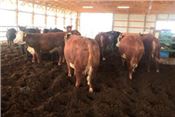Beef Producers Prioritizing Cow-Calf Comfort, Efficiency

Moving cows back to the bedding area.
Photo by Jeff Franklin
LEWISBURG, KEN.
Dairy cattle managers have long known the importance of minimizing stress in their herd. As such, they have gone to great lengths to make cows comfortable with cushy beds and other posh fixtures. Now some Kentucky beef producers are experimenting to see if one method will keep beef cattle more comfortable during the winter months.
David Appelman is a University of Kentucky Cooperative Extension Service agent for agriculture and natural resources in Bracken County.
He’s also a beef producer, who used to raise dairy cows. His grown children wanted to get into the cow-calf business.
“We did not have the facilities at all,” he said. “We were just an open pasture. We wanted a facility that allowed for easy management, and we wanted to optimize animal production.”
Appelman has seen how beneficial compost-bedded pack barns have been in the dairy industry. He visited the UK dairy farm and thought maybe the comfy cow barn would work well for beef.
A compost-bedded pack barn is an open-air barn with no stalls. The floor of the barn is covered with at least 10 inches of dry wood shavings or sawdust for bedding. The producer needs to rake the area twice daily with a tractor to add oxygen and keep it fluffy.
“When it comes to animal rest, that is something we have forgotten about, we don’t focus on, and we really have to keep in mind that if animals stand in muddy conditions, they are going to be standing for many more hours than normal,” he said. “You take six to eight hours of additional standing, just because it is muddy, I think that is where the real stress is coming from on all those beef animals.”
Appelman said the compost-bedded pack barn concept is best-suited for smaller herds. He said with 30 to 35 cows and their fall calves inside the facility, they stay out of the mud, and they have a controlled feeding environment and a way to minimize hay loss. It is a safe way to manage the herd, while making daily visual contact with the animals.
“We think about our farm population; we see our producers getting older and still working off the farm,” he said. “They are coming home at night. It’s dark; it’s muddy. They are taking the tractor out in the field going through gates and among animals that are pushing and shoving to get to feed. It is a dangerous situation for a lot of our producers.”
While a compost-bedded pack barn is not the norm in the beef industry, UK beef specialist Les Anderson believes it could work, in the right situation.
“A semi-confinement production situation gives a producer the opportunity to increase efficiency,” he said. “David’s design reduces feed costs by decreasing hay loss, by decreasing nutrient requirements for maintenance and gain and increasing the stocking rate. Cattle that fight mud and cold and wet temperatures simply require more feed to maintain the condition and thrive.”
The Applemans also have integrated an electronic monitoring system to aid in estrous detection and early diagnosis of disease.
“Over time, this increased efficiency of production will help this family overcome the overhead costs of the building,” Anderson said.
“Bottom line is cattlemen hate mud, and mud has many hidden costs.
These semi-confinement operations aren’t the answer for every producer, but the data collected here will help Kentucky producers make more sound decisions.” ∆